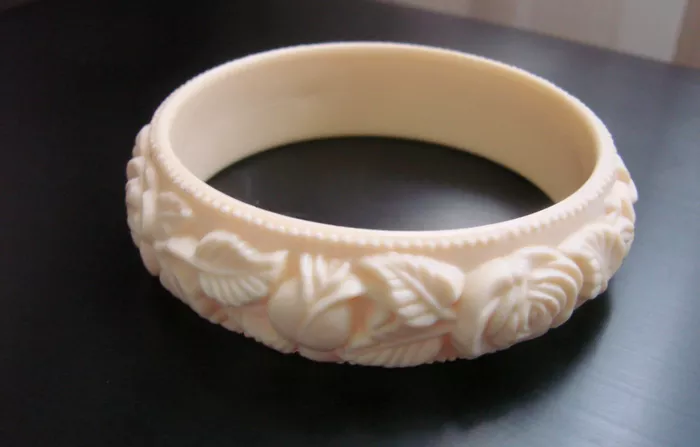Ivory, a material prized for its beauty and rarity, has been used for centuries to create a variety of items, including jewelry. Among these, ivory bracelets have been especially valued for their elegance and craftsmanship. However, the worth of a real ivory bracelet can vary significantly based on several factors. This article aims to provide a comprehensive understanding of the value of ivory bracelets in today’s market.
Historical and Cultural Significance of Ivory
Ivory has long been considered a symbol of wealth and status. Historically, it has been used in art, religious artifacts, and personal adornments. Ancient civilizations, including those in Africa, Asia, and Europe, highly valued ivory for its smooth texture and ease of carving. The use of ivory in jewelry, particularly bracelets, has been documented in various cultures, often signifying nobility and power.
Factors Influencing the Value of Ivory Bracelets
Several key factors determine the value of an ivory bracelet:
1. Age and Provenance
Older ivory bracelets, particularly those with documented historical significance or origins, tend to be more valuable. Provenance, or the history of ownership, can significantly affect an item’s worth. Antique ivory pieces from renowned collectors or significant periods in history are often highly sought after by collectors.
2. Craftsmanship and Design
The level of craftsmanship involved in creating an ivory bracelet plays a crucial role in its valuation. Intricately carved designs, fine details, and unique patterns can enhance the bracelet’s appeal and, consequently, its market value. Artisan pieces that showcase exceptional skill and creativity are particularly prized.
3. Condition
The condition of an ivory bracelet is another critical factor. Well-preserved pieces with minimal wear, cracks, or discoloration are more valuable than those showing significant signs of aging or damage. Restoration efforts can sometimes improve a piece’s condition, but original, untouched items typically command higher prices.
4. Size and Weight
Larger and heavier ivory bracelets generally hold more value due to the amount of raw material used. However, this is not an absolute rule, as smaller pieces with exceptional artistry can also be highly valuable.
5. Legality and Certification
The legality of ivory trade has a substantial impact on the value of ivory bracelets. Due to international bans and strict regulations aimed at protecting endangered species, legal ivory pieces that come with proper certification are more valuable. Items with documentation proving their legal acquisition and age (such as being pre-1947) are especially important for buyers.
6. Market Demand
Market trends and demand for ivory jewelry fluctuate. Cultural shifts, ethical considerations, and changes in fashion can influence the desirability of ivory bracelets. Periods of high demand can drive up prices, while reduced interest can lower them.
The Legal Landscape and Its Impact on Value
International regulations, such as the Convention on International Trade in Endangered Species of Wild Fauna and Flora (CITES), have placed stringent controls on the ivory trade to combat poaching and protect endangered species. In many countries, the sale of new ivory is banned, and only antique pieces with proper documentation are legally tradeable.
1. Impact of Regulations
These regulations have created a significant divide in the market between legal antique ivory and illegal or unverified pieces. Legal, certified antique ivory bracelets can command high prices due to their rarity and the difficulty in obtaining new ivory legally. Conversely, uncertified or illegally obtained ivory pieces have diminished value and come with legal risks for buyers and sellers.
2. Ethical Considerations
The ethical concerns surrounding ivory also impact its market value. Increasing awareness of the consequences of ivory trade on elephant populations has led many potential buyers to avoid ivory altogether, favoring alternative materials. This ethical stance can reduce overall demand, affecting prices.
See Also: Can I Wear Black Obsidian Bracelet While Sleeping
Valuation Examples
To provide a clearer picture, let’s look at some hypothetical examples of ivory bracelet valuations:
1. Antique Ivory Bracelet from the 19th Century
Age and Provenance: Documented to be from the Victorian era, owned by a notable family.
Craftsmanship: Intricately carved with detailed floral patterns.
Condition: Excellent, with no visible cracks or discoloration.
Certification: Comes with CITES certification proving it was legally acquired.
Estimated Value: $5,000 – $10,000
2. Mid-20th Century Ivory Bracelet
Age and Provenance: Mass-produced in the 1950s, with no notable historical significance.
Craftsmanship: Simple design with minimal carving.
Condition: Good, with minor wear and slight discoloration.
Certification: Accompanied by legal documentation.
Estimated Value: $1,000 – $2,500
3. Contemporary Ivory Bracelet
Age and Provenance: Created in the late 20th century, without significant historical background.
Craftsmanship: Moderately detailed, standard design.
Condition: Fair, with visible signs of use.
Certification: Lacks proper certification, questionable legality.
Estimated Value: $500 – $1,200 (assuming it can be legally traded)
Conclusion
Determining the value of a real ivory bracelet involves considering multiple factors, including age, provenance, craftsmanship, condition, and legality. Antique pieces with historical significance and proper certification are typically the most valuable, while contemporary items or those without proper documentation may hold less worth and come with legal and ethical concerns.
In today’s market, the value of ivory bracelets is influenced by both tangible factors like material quality and intangible aspects such as market trends and ethical considerations. As regulations and societal attitudes continue to evolve, the market for ivory jewelry will likely see further changes, making it essential for buyers and sellers to stay informed and act responsibly.

